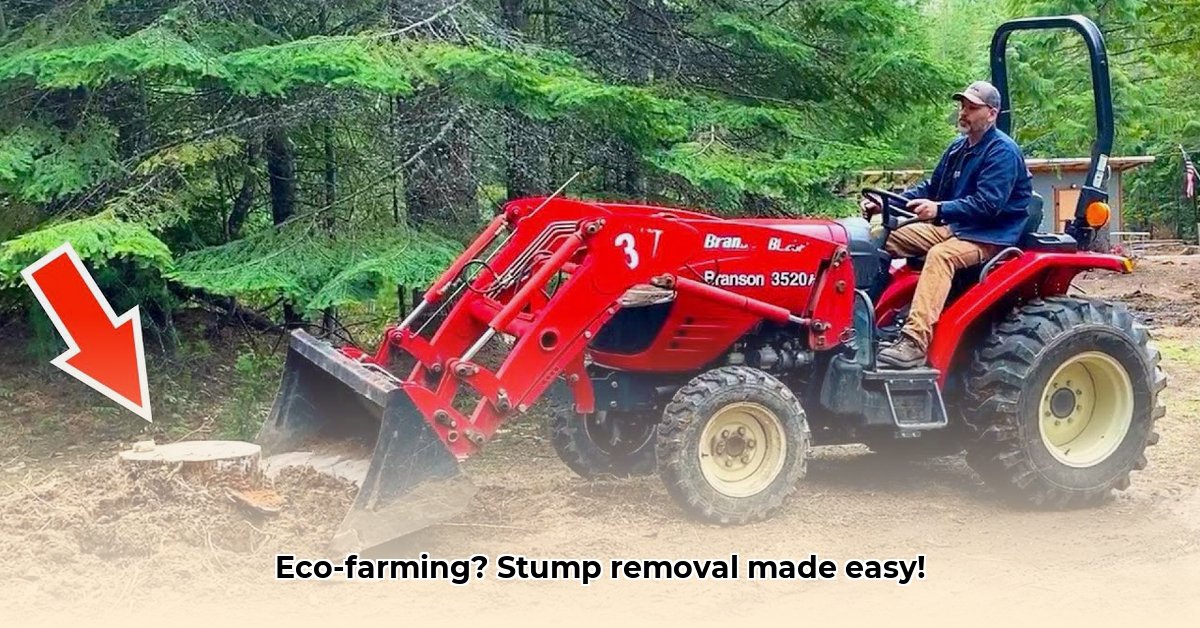
Getting rid of tree stumps efficiently and sustainably is crucial for eco-farming. This guide compares two popular tractor-based methods—one using a powerful machine like a John Deere, and another employing a more labor-intensive approach with a smaller tractor (e.g., a Fiat)—to help you choose the best option for your farm. We'll examine costs, environmental impact, and safety, guiding you toward responsible stump disposal. For smaller tractors, check out small tractor attachments.
Method 1: The High-Power Approach (John Deere Example)
This method prioritizes speed and efficiency, ideal for large-scale operations. Think of it as the "get-it-done-fast" approach for numerous or large stumps.
Equipment: A high-horsepower tractor (John Deere example), a powerful stump grinder, and potentially an excavator for stubborn stumps.
Steps:
- Assess: Carefully examine the stumps and surrounding area. Note size, density, and ground conditions. This assessment impacts tool selection and safety planning.
- Position: Strategically place the tractor and grinder for optimal operation and safety.
- Grind: Engage the grinder, systematically removing the stump. Overlapping passes ensure complete removal.
- Excavate (if needed): Use the excavator to remove remaining roots if the grinder isn’t sufficient.
- Dispose: Safely transport the wood chips to a designated area for composting, mulching, or other sustainable disposal methods.
Pros: Fast, efficient, ideal for many or large stumps.
Cons: High initial equipment cost, higher fuel consumption (environmental impact), requires specialized training and experience.
Cost: High initial equipment cost, significant fuel costs, potential excavator rental fees.
Sustainability: Lower environmental impact compared to older models due to improved fuel efficiency and emissions controls, but still has a carbon footprint.
Method 2: The Labor-Intensive Approach (Fiat Example)
This budget-friendly method emphasizes resourcefulness and often gentler land management. It's a perfect option for smaller farms or limited budgets.
Equipment: A smaller, more maneuverable tractor (Fiat example), a smaller stump grinder, chains, a winch, and possibly hand tools (axes, shovels).
Steps:
- Evaluate: Assess the site, stump size, and accessibility. This determines the best approach to breaking down and removing the stumps.
- Loosen: Use manual methods (chains, winches) or hand tools to loosen larger stumps, creating easier access for the grinder. This reduces wear on the smaller equipment.
- Grind & Extract: Grind the stump into manageable pieces, using the tractor for positioning and leverage. Manual removal might be necessary for some pieces.
- Clean Up: Carefully remove all debris, avoiding damage to surrounding areas.
Pros: Lower initial investment, potentially lower operational costs, suitable for smaller farms.
Cons: More physically demanding, slower process, less efficient for large-scale stump removal, requires more manual skill and labor.
Cost: Lower initial investment, lower fuel costs, but higher labor costs.
Sustainability: Lower fuel consumption, but the labor component contributes to the overall environmental footprint. However, this can be mitigated with appropriate waste management strategies.
Comparing Methods: A Summary Table
| Feature | High-Power (John Deere) | Labor-Intensive (Fiat) |
|---|---|---|
| Initial Cost | High | Low |
| Operating Cost | High | Low to Moderate |
| Speed | High | Low |
| Efficiency | High | Moderate |
| Environmental Impact | Moderate (fuel) | Low (fuel) |
| Labor Required | Low | High |
Choosing the Right Method for Sustainable Stump Removal
The optimal choice depends on your specific needs. Consider these factors:
- Budget: High or low budget for equipment and labor?
- Stump Size & Number: Small or large? Few or many?
- Time: How much time is available for removal?
- Environmental Concerns: Prioritize minimizing environmental impact (fuel consumption or manual labor)?
- Available Resources: What equipment and labor are available?
Sustainable Stump Disposal: Environmental Responsibility
Responsible disposal minimizes environmental harm. Options include:
- Composting: Grind wood into small pieces for faster decomposition, creating valuable soil amendment.
- Mulching: Use wood chips as mulch for gardens or landscaping.
- Biochar: Convert wood into charcoal for soil improvement (specialized equipment required).
- Responsible Burning: Only permitted in designated areas and according to local regulations. Burning is generally not preferred due to air quality concerns.
Choosing the right method and practicing sustainable disposal ensures efficient and environmentally friendly stump removal, paving the way for a thriving, sustainable farm. Remember, safety is paramount—wear appropriate personal protective equipment (PPE) and follow all safety guidelines for tractor operation and handling of tools.